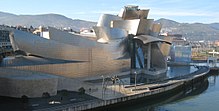Starchitect
Starchitect is a
The Bilbao Effect
Buildings are frequently regarded as profit opportunities, so creating "
However, it was the rise of
But a high-tech strand of modernism persisted in parallel with a formally retrogressive post-modernism; one that often championed "progress" by celebrating, if not exposing, structure and systems engineering. Such technological virtuosity can be discovered during this time in the work of

With urban generation from the turn of the twentieth century picking up,
The origin of the phrase "wow factor architecture" is uncertain, but has been used extensively in business management in both the UK and United States to promote avant-gardist buildings within urban regeneration since the late 1990s.
The "wow factor" has also been taken up by Spanish architecture critics such as
Historical overview of the status of architects

The notion of giving celebrity status to architects is not new, but is contained within the general tendency, from the Renaissance onwards, to give status to artists. Until the modern era, artists in Western civilization were generally working under a patron – usually the Church or the rulers of the state – and their reputation could become commodified, such that their services could be bought by different patrons. One of the first records of celebrity status is artist-architect Giorgio Vasari's monograph Le vite de' più eccellenti pittori, scultori e architettori (in English, Lives of the Most Excellent Painters, Sculptors, and Architects), first published in 1550, recording the Italian Renaissance at the time of its flourishment. Vasari, himself under the patronage of Grand Duke Cosimo I de' Medici, even favoured architects from the city where he resided, Florence, attributing to them innovation, while barely mentioning other cities or places further away. The importance of Vasari's book was in the ability to consolidate reputation and status without people actually having to see the works described.[9] The development of media has thus been equally of central importance to architectural celebrity as other walks of life.
While status arising from patronage from the Church and State continued with the rise of
Such publicity also made it into the popular press: in the post-war era
Measuring celebrity status
Objectivity in the question of status would seem questionable. However, researchers at
Prizes and the consolidation of reputation
Although there are few architects well known to the general public, "starchitects" are held in the highest esteem by their professional colleagues and the professional media. Such status is marked not only by prestigious commissions but also by various prizes. For example, the
In his 1979 book Architecture and its Interpretation, Juan Pablo Bonta put forward a theory about how buildings and architects achieve canonic status.
However, there is a difference between canonic status and "starchitect": as part of the "wow-factor" aspect of the term depends on current media visibility, it is used only to describe currently practicing architects:
- Frank Gehry
- Santiago Calatrava
- Álvaro Siza
- Massimiliano Fuksas
- Kazuyo Sejima and Ryue Nishizawa (SANAA)
- Sou Fujimoto
- David Childs (Skidmore, Owings & Merrill)
- Tadao Ando
- Norman Foster
- Jeanne Gang
- Nicholas Grimshaw
- Steven Holl
- Christoph Ingenhoven
- Toyo Ito
- Rem Koolhaas
- Daniel Libeskind
- Greg Lynn
- Winy Maas (MVRDV)
- Morphosis)
- Richard Meier
- Herzog & de Meuron
- João Luís Carrilho da Graça
- Rafael Moneo
- Jean Nouvel
- Renzo Piano
- Eduardo Souto de Moura
- William Pedersen (Kohn Pedersen Fox)
- Christian de Portzamparc
- Joshua Prince-Ramus(REX)
- Wolf D. Prix (Coop Himmelb(l)au)
- Robert Stern
- Richard Rogers
- Ben van Berkel (UNStudio)
- Bernard Tschumi
- Rafael Viñoly
- Peter Zumthor
- Bjarke Ingels (BIG)
- Kjetil Trædal Thorsen(Snøhetta)
Former starchitects
- Josef Hoffmann
- Mimar Sinan[16][17]
- Le Corbusier
- Antoni Gaudí
- Luis Barragán
- Lluís Domènech i Montaner
- Mario Botta
- Peter Eisenman
- Michael Graves
- Muzharul Islam
- Philip Johnson
- Ludwig Mies van der Rohe
- Oscar Niemeyer
- I. M. Pei
- Kevin Roche
- Eero Saarinen
- Robert Venturi
- Denise Scott Brown
- Frank Lloyd Wright
- Zaha Hadid
- Gae Aulenti
- Charles Gwathmey
- Pelli Clarke Pelli)
- Helmut Jahn
See also
References
- ^ Davide Ponzini and Michele Nastasi, STARCHITECTURE: Scenes, Actors and Spectacles in Contemporary Cities. Turin, Allemandi, 2011. http://www.starchitecture.it/category/book
- The Creative City: A Toolkit for Urban Innovators. London; Earthscan, 2003.
- ^ Charles Jencks, What is Postmodernism? London, Academy Editions, 1984.
- ^ Charles Jencks, "The new paradigm in architecture" in Absolute Motion, Datutop 22, Tampere, 2002.
- The Atlantic Monthly, September 2002.
- ^ The term has been used more often in business management. See for instance: Tom Peters, The pursuit of wow, New York, Vintage, 1994.
- ^ Paul Kelso, "Architects urged to go for the 'wow factor' in designs for Britain's new public buildings", The Guardian, November 27, 2000.
- ^ Nicolai Ouroussof, "The New New York Skyline", New York Times, September 5, 2004
- ^ D. J. Gordon and Stephen Orgel, "Leonardo's Legend", ELH, Vol. 49, No. 2, Summer, 1982.
- ^ Spiro Kostof, The Architect: Chapters in the History of the Profession, University of California Press, 2000.
- ^ Eeva-Liisa Pelkonen and Donald Albrecht (eds), Eero Saarinen. Shaping the Future New Haven, Yale University Press, 2006.
- ^ Justin Henderson, Museum Architecture, Rockport Publishers, 2001.
- ^ Mike Martin, "Scientists Use Google To Measure Fame vs. Merit", Sci-tech today.com - May 20, 2004, [1]
- ^ Pritzer Home page Archived 2010-01-10 at the Wayback Machine
- ^ Juan Pablo Bonta, Architecture and its Interpretation. London, Lund Humphries, 1979
- ^ Ferren, Andrew (8 June 2012). "Tracking Turkey's First Starchitect". The New York Times.
- ^ "Sinan: The First Starchitect". www.buildingcentre.co.uk. Archived from the original on 2016-05-21.
